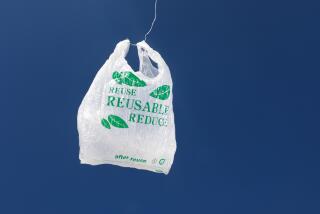Consumer question: When is âgreenâ logging really green?
SEATTLE â The seal looked appealing, a daisy on a field of green, with the words âTested Green.â It was issued to more than 120 products as a guarantee of environmental responsibility.
The problem, federal trade regulators announced in 2011, was that almost anybody who wanted to pay the $189.95 for a ârapidâ certification got a logo.
âIt took us about 30 seconds to have the Federal Trade Commission certified as âtested green,â and we were neither tested nor green,â Jim Kohm, head of the FTCâs enforcement division, said Thursday. âThey were saying that they were members of this certification body. But it turns out that the certification body was them.â
Federal trade authorities alleged a violation of consumer protection laws and reached a settlement that prohibited the company from claiming that any outside party had evaluated the products it certified -- or that the company had any environmental product expertise.
The enforcement action was one of a growing number the FTC has been asked to undertake as often-unverified claims of environmental friendliness wield increasing financial muscle in the marketplace.
Federal trade authorities are now being asked to take up a much more complicated question concerning how products can be certified as âgreen.â The question: How can buyers of lumber, paper and other wood products be guaranteed sufficient information to know that that their purchases arenât funding massive clearcuts and wildlife habitat destruction?
FTC officials said a complaint filed this week in Seattle against the Sustainable Forestry Initiative â one of the largest certifiers of good logging practices â will be evaluated against a new set of standards adopted in October designed to weed through a growing thicket of environmental marketing tactics, some with dubious foundations.
âThereâs definitely been a resurgence of environmental claims. Over the last five or six years, I would say, a wave of green claims. Itâs one of the reasons the commission expedited the âGreen Guidesâ review,â said Kohm, who could not discuss the specifics of the new forest practices complaint.
The Sustainable Forestry Initiative is far from a scam â even its critics acknowledge that the certifying body requires independent audits of forestry practices based on a known set of standards for managing forests in a sustainable fashion.
The complaint, detailed in an article Thursday, claims the Sustainable Forestry Initiative is not disclosing substantial financial ties to the timber industry that might affect how it defines and applies those standards.
Campaigners for ForestEthics, which filed the complaint along with Greenpeace, contend that the Sustainable Forestry Initiative certifies much more lenient logging practices than a rival certifying body, the Forest Stewardship Council, and undermines those in the marketplace who adhere to the more rigorous standards.
Sustainable Forest Initiative officials said Thursday the new complaint is âsubstantially similarâ to one filed by conservationists in 2009 on which the FTC took no enforcement action.
Its forestry standards are set by a group of independent experts that represent conservation, professional, academic and public organizations, the organization said in a new statement, and the program participants who supply 93% of its funding come not just from forest product companies, but also government agencies, foundations, universities and conservation groups.
(The list posted on SFIâs website shows 100 âparticipantsâ who have received SFI certification through independent audits, including some of the nationâs largest timber companies. An additional 54 have also signed on as paying members of SFI and have agreed by unaudited contract to uphold its forestry standards, though they receive no SFI certification. These include 39 logging or wood products companies, seven universities, four state natural resources agencies, one environmental group from New Hampshire, a public garden and an estate.)
In an interview Thursday, SFI President and Chief Executive Kathy Abusow, said FSC, the other wood products certification body, also receives funding from timber companies that apply for certification.
Any company or product that receives SFI certification, she said, has been examined by independent, third-party auditors overseen by the American National Standards Institute and the American National Accreditation Board.
Some conservations still question the ties between SFI and other entities.
âEverything about the SFI from its funding to its governance [board dominated by industry] to the logging companies that are its primary benefactors [and beneficiaries, e.g., Weyerhaeuser] shows that SFI is totally dependent on the logging industry,â said Aaron Sanger, campaigner for ForestEthics.
Conservation groups who filed the complaint say an analysis they conducted in 2009 showed that FSC fielded larger audit teams that spent five times longer in the field monitoring logging operations than did SFI. FSC teams identified an average of 23 instances of noncompliance with standards, while SFI teams found an average of two, according to the conservationistsâ study.
Abusow explained the relatively fewer problems identified by SFI auditors by saying thatthose seeking SFI certification already are committed to good forest practices before they apply.
In a marketplace stocked with forest products from all over the world, the issue of who is certifiably âgreenâ can become confusing even to those doing the labeling, she said.
âIf youâre a paper maker and youâre operating here in the U.S., itâs not like you get an FSC forest, and all that wood comes nicely into an FSC pulp mill and out of that comes FSC paper. It isnât at all how it works. There is an uncertified forest, there are SFI-certified forests, there are FSC-certified forests, they go into various mills. Thereâs chips left over that get fed in somewhere else,â she said.
âAll of that gets aggregated in a pulp mill, and they say, OK, we know we have 20% FSC here and 30% SFI there.⌠These are mixed supply chains.â
What logo do they put on the label? How is a consumer to decide?
Kohm said the FTCâs new âGreen Guidesâ zero in on whether there is a âmaterial connectionâ between the certifier and the company certified that would be important to the consumer.
âWhat we think consumers are concerned about is any connection that would indicate that the standards either are inferior to what theyâd otherwise be, or that the standards are applied poorly,â he said.
âWhat we said is, if youâre an industry group and you use standards that are developed independently through a voluntary consensus process, that means all the stakeholders are part of the process, that itâs not in any way dominated or industry has a veto in the process, and those standards are applied objectively by a third partyâthen thereâs no reason to disclose.â
Abusow said SFI is launching a standards revision next month âto see if we can find a way to even further improve transparence, to further help consumers understand what it means to see the SFI label in the marketplace.â
In the meantime, she said, the real challenge is to encourage companies to seek certification in the first place.
âOnly 10% of the worldâs forests are certified at all,â she said. âWhat weâre doing here is arguing about whoâs the A-plus student and whoâs the A-minus student, and not paying attention to the 90% where youâre going to have a higher risk of deforestation, higher risk of conversion, higher risk of illegal logging from offshore.â
ALSO:
Recall effort against Arizonaâs Joe Arpaio fails
Ricin letter sent to N.Y. mayor over gun control
Conservation groups challenge âgreen forestâ products
More to Read
Sign up for Essential California
The most important California stories and recommendations in your inbox every morning.
You may occasionally receive promotional content from the Los Angeles Times.










